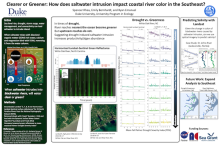Clearer or Greener: How does saltwater intrusion impacting coastal river color in the Southeast?
Spencer
Rhea
Duke University
Emily Bernhardt: Duke University
Ryan Emanuel: Duke University
Ryan Emanuel: Duke University
Poster
As sea levels rise, coastal freshwater ecosystems are at greater risk of saltwater intrusion. River color, an intuitive and inexpensive indicator of water quality, can be a valuable way to track and assess changes in coastal rivers. When saltwater mixes with the organic matter rich rivers of the southeast, salt ions bind with colored dissolved organic matter (cDOM), removing the compound from the water column and increasing light availability. This change could either result in water clearing or greening, as algae respond to greater light availability. To understand how drought induced saltwater intrusion impacts coastal river color, we extracted Harmonized Landsat-Sentinel Surface Reflectance data for 33 coastal rivers in North Carolina and Palmer Drought Severity data for their watersheds. Our results indicate river segments closest to the ocean experience greening during droughts in the summer and fall with the greatest effect seen in rivers that predominantly drain the coastal plain. These results suggest coastal rivers rich in cDOM may become more productive as sea levels rise and saltwater intrudes into coastal rivers more frequently.
Poster PDF

Meeting homepage